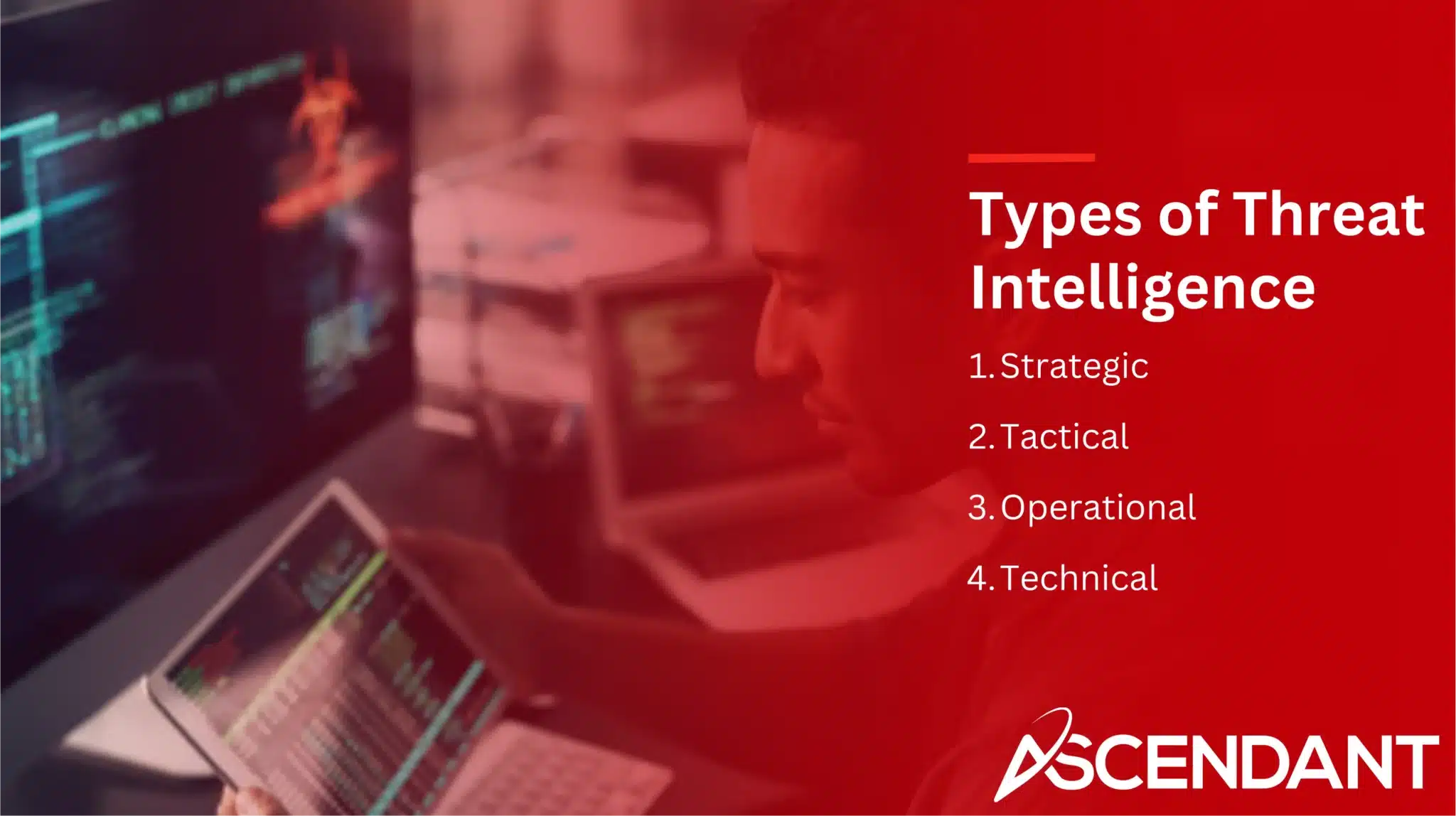Threat intelligence is about gathering and analyzing data to defend against cyber threats. It’s critical for preempting attacks and strengthening cybersecurity measures. This article highlights top threat intelligence tools for 2024 and how they can boost your defenses.
Key Takeaways
- Threat intelligence enhances cybersecurity by providing actionable insights into current and emerging threats, enabling organizations to proactively mitigate risks.
- There are four primary types of threat intelligence: strategic, tactical, operational, and technical, each serving distinct purposes for different decision-making levels.
- The integration of artificial intelligence and machine learning in threat intelligence tools is crucial for improving threat detection and response efficiency in the evolving cyber threat landscape.
Understanding Threat Intelligence
Cyber threat intelligence (CTI) is the systematic gathering, evaluation, and interpretation of data regarding potential or current cyber threats. This process equips organizations with crucial insights that enable them to preventively address vulnerabilities in their systems and infrastructure. By providing a comprehensive view of both physical and digital dangers within the global landscape—including geopolitical factors—cyber threat intelligence plays an essential role in strengthening security measures through well-established CTI programs.
As cyber-attacks grow increasingly sophisticated, the significance of integrating effective cyber threat intelligence has never been higher for maintaining robust defense strategies. It empowers entities to swiftly pinpoint and tackle imminent threats before they result in costly security breaches, thereby bolstering their defensive stance against such incursions.
For those engaged in fortifying networks against these risks, it’s vital to grasp the essence of a competent threat intelligence program: sourcing reliable data on emerging threats, employing advanced analytical techniques, and utilizing this refined knowledge decisively for protective actions. Together these elements arm security teams with pivotal resources necessary for safeguarding organizations in today’s volatile threat environment.
Definition and Importance
Cyber threat intelligence encompasses detailed information and analysis regarding potential or existing cyber threats that an organization might encounter. This includes understanding the tactics, intentions, and possible repercussions for businesses. Its primary objective is to validate the authenticity of a cyber threat while delivering actionable insights for its mitigation. The main role of a threat intelligence team involves scrutinizing data which plays a crucial part in thwarting cyber attacks and pinpointing emerging threats.
Underscoring the value of threat intelligence is essential as it sheds light on attackers’ profiles – their strategies, purposes, capabilities – alongside warning signs known as indicators of compromise (IOCs). This knowledge significantly enhances comprehension of the prevailing threat landscape. Threat intelligence not only provides immediate updates about external third-party threats, but also assists organizations in appraising risks effectively. Consequently, firms are able to shift from reactionary defenses to proactive security measures against such challenges.
Key Components of Threat Intelligence
In the realm of cyber threat intelligence, it’s essential to amalgamate data from diverse origins such as open source platforms, social media analytics, human-derived insights, and technical intelligence. This fusion yields a holistic understanding of the evolving threat landscape that empowers security experts to preemptively refine their defense mechanisms and thwart impending cyber threats. Regular updates – which may be daily or weekly – keep organizations abreast with newly surfacing hazards.
The pivotal role played by Threat Intelligence Platforms (TIPs) lies in streamlining various sources of threat intelligence feeds for more effective detection and prevention strategies against potential incursions. These systems enable customization through elements like graphical representations, findings from proactive hunting exercises, shared rulesets, and curated collections to efficiently orchestrate intel management. Such robust integration equips entities with the foresight needed to outpace advanced persistent threats along with other formidable challenges within cybersecurity domains.
Types of Threat Intelligence

There are four main classifications of threat intelligence, which consist of:
- Strategic
- Tactical
- Operational
- Technical
Each category targets specific needs and supports various decision-making echelons in an organization. Collectively, they form a full-fledged strategy to confront cybersecurity threats and enhance the security posture comprehensively.
Strategic Threat Intelligence
Strategic threat intelligence serves to guide high-level executives in crafting decisions pertinent to risk and the firm’s security stance, incorporating external threat data gleaned from a variety of sources that include communities, forums, and both open and dark web environments. The alignment of an organization’s goals is enhanced through this strategic intelligence by defining the specific types of intelligence needed and identifying responsible team members.
By shedding light on the extensive threat landscape, strategic threat intelligence equips organizations with a deeper understanding of how future attacks could potentially affect them. This formulates an essential element for strategizing long-term security measures as well as managing risks effectively. Equipped with this knowledge derived from reliable insights allows for informed decision-making pertaining to organizational safety protocols.
Tactical Threat Intelligence
Tactical intelligence threat intelligence focuses on the tactics, techniques, and procedures (TTPs) of threat actors. It provides detailed insights into the behaviors and methods used by attackers, which are essential for building effective defense strategies. Understanding the TTPs allows organizations to adapt their defenses to counter imminent threats and mitigate the impact of cyber attacks.
Mapping TTPs contributes to a proactive security strategy, allowing for smarter defense planning. Tactical threat intelligence strengthens existing security controls and helps identify and remove vulnerabilities, enhancing an organization’s overall security posture.
Disseminating tactical cyber threat intelligence reports is crucial for sharing actionable information with security professionals.
Operational Threat Intelligence
Focusing on particular threats and campaigns, operational threat intelligence supplies organizations with contextual details vital for recognizing imminent dangers. It leverages AI technologies to improve the profiling of threats and analysis of data. Such operational intelligence is essential in real-time threat mitigation and is a critical component for incident response strategies.
Technical Threat Intelligence
Technical threat intelligence is concerned with the granularities of compromise indicators, malware fingerprints, and other intricate technical details. Its primary objective is to furnish in-depth knowledge about susceptibilities and harmful software, paying special attention to patterns of behavior, means of dissemination, and possible repercussions. The timeliness of this information is crucial because the relevance of compromise indicators can diminish rapidly.
Analysts specializing in threat intelligence are responsible for collecting security-related data pertaining to IOCs (Indicators Of Compromise) and anomalous activities. Their monitoring extends to malevolent domains and IP addresses as well. By offering continuous flows known as threat feeds—packed with actionable insights regarding threats and adversarial entities—they simplify decision-making processes while expediting the implementation of defensive actions.
The fusion of these external feeds with an organization’s internal data substantially amplifies its capacity for early detection and effective response against looming threats.
The Threat Intelligence Lifecycle
The lifecycle of threat intelligence is a systematic and repetitive process which includes the stages of direction, collection, processing, analysis, dissemination, and feedback. Every phase plays an essential role in promoting continuous enhancement and honing of the intelligence cycle to assist organizations in maintaining an advantage over cyber threats.
Direction and Collection
The initial step, known as the direction phase, is centered on establishing clear objectives for the threat intelligence program that are in sync with an organization’s specific needs and priorities. This alignment necessitates pinpointing exactly which data, assets, and business processes require protection according to corporate goals.
At the core of a strong threat intelligence program lies the proficient collection of threat data. Amassing extensive and detailed information through security logs, engaging with informative sources directly or via conversations, and integrating insights from various threat feeds enables organizations to effectively recognize potential threats and deploy measures to counteract them.
Processing and Analysis
In the processing phase, unnecessary data is discarded and the relevant information is organized into a format that can be conveniently utilized. This process significantly improves analysts’ capacity to collect information effectively and reduces the probability of missing important details.
The purpose of the analysis phase is for analysts to draw meaningful conclusions from their compiled data in order to comprehend both the characteristics and potential consequences of threats. The aim here is to develop practical knowledge that aids decision-makers in enhancing their organization’s security posture.
Data derived from actual incidents of exploitation holds great significance because it allows vulnerabilities to be prioritized according to insights obtained through threat analysis.
Dissemination and Feedback
Distribution is crucial, as it guarantees that pertinent stakeholders receive the polished intelligence in a format that they can comprehend and act upon. Receiving feedback is vital for ensuring the threat intelligence program’s lifecycle stays in sync with an organization’s changing needs and priorities, thus fostering ongoing advancement.
Evaluating an effective threat intelligence program plays a significant role in determining its effectiveness and pinpointing opportunities for Development.
Implementing a Threat Intelligence Program
Establishing a threat intelligence program entails defining goals and determining priorities, choosing appropriate tools and platforms, as well as assembling a competent team. Such a program enables stakeholders to comprehend how threats can impact business goals, which in turn facilitates informed strategic decisions.
Setting Objectives and Priorities
To combat the escalating complexity and variety of cyber threats, organizations need to evolve their threat intelligence approaches. It is critical that these strategies are tailored to meet the specific priorities of an organization in order to achieve a robust cybersecurity defense.
Instituting proactive steps is key for pre-empting and neutralizing potential threats before they become actual issues. When clear goals and priorities are established, it strengthens an organization’s defensive posture against cyber threats and accelerates its response capacity when incidents occur.
Selecting Tools and Platforms
Selecting the right tools and platforms is vital for integrating threat intelligence with existing security systems, significantly enhancing an organization’s overall security posture. Effective data management relies on the integration of tools, which can provide a unified view of threats and streamline threat detection and response efforts.
Integrating threat intelligence with security systems such as SIEM and SOAR improves the overall security effectiveness by correlating threat data with existing security measures. This integration allows for faster incident response and better-prepared defenses.
Building a Skilled Team
The ever-changing landscape of security necessitates an ongoing need for individuals adept in cyber threat intelligence. The recruitment of such proficient professionals poses significant hurdles for operations tasked with ensuring security.
Training focused on cyber threat intelligence is imperative to build and refine abilities related to analyzing threat data. Earning certifications designed for cyber intelligence analysts is critical to demonstrate both trustworthiness and expertise. For creating a robust team skilled in handling threats, it’s important that an efficient strategy be employed to attract this talent.
Practical Applications of Threat Intelligence
Threat intelligence serves critical functions in incident response, vulnerability management, and threat hunting. It equips organizations with the knowledge to identify risks and enact preventive steps to ward off or lessen the impact of cyber-attacks.
Incident Response
Incorporating threat intelligence into established security protocols is crucial for enhancing decision-making during incident response. This fusion of intelligence and security mechanisms bolsters situational awareness, which in turn accelerates the responsiveness to potential threats.
Leveraging threat intelligence allows organizations to gain deeper insights into the profiles and intentions of threat actors. This knowledge facilitates a more focused and efficient approach when crafting strategies for incident response.
Vulnerability Management
Vulnerability management is significantly enhanced by threat intelligence as it singles out critical vulnerabilities currently under exploitation. Such insight allows security teams to prioritize remediation and take proactive steps to secure systems against identified weaknesses.
It’s vital for effective vulnerability management that asset exposure, early detection of threats, and comprehensive vulnerability intelligence are integrated. This fusion provides security teams with detailed information regarding specific attack vectors and the associated vulnerabilities they need to track and scrutinize during threat investigations.
Threat Hunting
Organizations improve their proactive threat hunting capabilities by creating customized risk profiles, which shed light on the behaviors and campaigns of threat actors. By anticipating particular cyber threats and using knowledge from across the industry to simulate possible attacks, organizations can maintain an advantage over potential security risks.
The adoption of crowdsourced detection rules plays a vital role in refining threat hunting strategies. Such preventive methods and simulation tactics empower organizations to bolster their capacity for detecting threats—especially those that may evade conventional detection approaches—thereby strengthening their overall ability to identify emerging cyber threats.
Future Trends in Threat Intelligence
Trends in threat intelligence that are on the rise promise to transform the way organizations counter cyber threats. The future of cybersecurity will be significantly influenced by how artificial intelligence and machine learning are incorporated into it, as well as by changes in the landscape of threats.
Artificial Intelligence and Machine Learning
The use of machine learning in threat intelligence involves handling large volumes of data to increase the efficiency of detecting threats. When machine learning is incorporated into cybersecurity, it automates regular tasks and empowers security professionals to concentrate on more strategic efforts.
Artificial Intelligence and machine learning improve threat detection by scrutinizing user behavior and monitoring network traffic for signs of impending attacks. By establishing what constitutes normal activity through anomaly detection, which is powered by machine learning, any irregularities are marked as potential threats. This makes threat intelligence tools increasingly proactive in swiftly identifying and reacting to threats.
Integration with Other Security Systems
Merging threat intelligence into security systems can furnish a comprehensive perspective on the threat landscape, boosting an organization’s capabilities in countering cyber threats adeptly. By correlating gathered threat data with current security measures through this integration, organizations fortify their defense mechanisms against forthcoming attacks.
Standard platforms for such integrations include Security Information and Event Management (SIEM) tools, Intrusion Detection Systems (IDS), and Endpoint Detection and Response (EDR) technologies. Exchanging pertinent threat information bolsters these integrated systems’ efficiency by mitigating alert exhaustion while guaranteeing that security teams concentrate on critical threats.
Evolving Threat Landscape
As the threat landscape consistently shifts, aggressors are adopting increasingly complex strategies. This necessitates organizations to modify their protective measures in response. The expected developments encompass a rise in cyberattacks backed by nation-states and advanced ransomware methodologies.
To ensure that security defenses can stand up to the perpetually transforming threats, organizations need to maintain flexibility and enhance their threat intelligence frameworks with diverse data inputs from sources such as IoT devices and mobile applications. Through this continuous evolution of defense mechanisms, they can effectively combat the dynamic nature of today’s threat landscape.
 Summary
Summary
In summary, understanding and implementing effective threat intelligence is crucial for any organization aiming to enhance its cybersecurity posture. From defining and categorizing threat intelligence to exploring the lifecycle and practical applications, this guide has provided a comprehensive overview. As we move into 2024, the integration of AI, machine learning, and other advanced technologies will continue to shape the future of threat intelligence, helping organizations stay ahead of evolving threats. Stay proactive, stay informed, and leverage the right tools and strategies to protect your assets and systems.
Frequently Asked Questions
What is cyber threat intelligence?
Cyber threat intelligence (CTI) provides organizations with critical insights into potential cyber threats, including their methods, motivations, and potential impact on business.
Understanding CTI is essential for effective risk management and cybersecurity strategies.
Why is threat intelligence important for organizations?
Threat intelligence is essential for organizations as it offers valuable insights into attackers’ motivations and capabilities, thereby improving the understanding of the current threat landscape and enabling more effective security measures.
What are the types of threat intelligence?
Understanding the distinct categories of threat intelligence is critical for effectively tackling security concerns within an organization. The key types include strategic, tactical, operational, and technical intelligence, all of which aid in various organizational decision-making processes.
How does AI and machine learning enhance threat intelligence?
AI and machine learning enhance threat intelligence by efficiently managing large datasets, automating routine tasks, and facilitating anomaly detection, which helps identify potential threats.
This technological integration allows for a more proactive and responsive security posture.
What is the significance of integrating threat intelligence with other security systems?
The combination of threat intelligence and existing security systems is critical because it provides an extensive view of possible threats, enhances the ability to detect them, and expedites incident response by associating threat data with previously implemented security measures.

